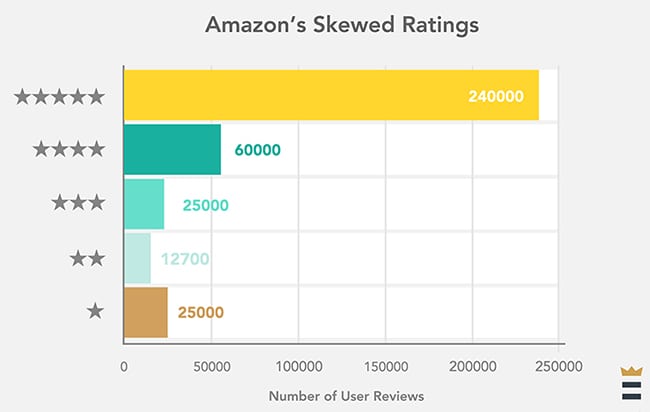Today’s shoppers are confronted with seemingly endless options, leaving them with a serious case of decision fatigue. As a result, many of them experience shopping frustration, make snap decisions or decide to take the “nochoice” option, choosing to defer a purchase decision.
As choice overload becomes a very real issue across industries for customers and businesses alike, more and more businesses are looking into solutions to help their visitors discover, choose and decide for the perfect product to purchase. Offering a smooth and quick path to the right product is not a choice. If you don’t, someone else will.
Realizing the negative implications choice overload has for your business and doing something about it helps you to differentiate and improve the overall perception of your company.
There are several ways how you can accomplish this. But how good are these? I’ve tested the most promising approaches:
1) Recommendations
You can dynamically customize the users experience based on prior searches, page views or created wish lists to keep them engaged and browsing. It also lets you increase the upselling potential by suggesting complementary products and accessories.
The success of this approach is strongly tied to your ability to proffer relevant products and solutions. When you’re looking for a new face cleanser for mature skin and a teenager zit-action wash pops up – not ideal. In fact, this kind of wild, random approach is likely to turn customers off and make them doubt your authority. Putting time into devising a useful algorithm and leveraging big data will reap the rewards.
Take eBay as an example. I lost out on a dress I had bid on and straight away eBay acknowledged that I hadn’t won the auction and provided with me with some alternatives. It’s managed to ascertain my size, the colour (mostly) and even the beading detail. As a customer, I found this very impressive.

ASOS takes this idea even further. The online retail giant knows its shoppers want to look good, but it also knows we don’t have time to sift through literally thousands of items. So what do they do? Style outfits and allow shoppers to buy the whole outfit in one go.

THE VERDICT – RECOMMENDATIONS:
- Increases customer engagement
- Encourages browsing and discovery
- Offers opportunities for cross-selling and upselling
- Amplifies key metrics like conversion rates and CTR only if personalized, context-aware and relevant
- The importance of big data and machine-learning should not be underestimated
2) Quizzes
BuzzFeed has shown how much people crave personal quizzes. They are able to drive a ton of social traffic, which can help you attract and engage your audience to turn them into buyers.
A quiz is able to direct shoppers to products that fit their personality, body type, interests, preferences, and more.
A great example is the forward-thinking German fashion retailed OTTO. In a bid to give customers a shopping experience to remember, they have provided shoppers with an interactive Style Quiz along with a Fit Quiz. They ask insightful, on-brand questions such as ‘Time to praise yourself! What do you like about your body?’

After the quiz, OTTO gives the customer a list of relevant fashion tips and a list of items that best match the customer’s needs.
The result? Happy shoppers who don’t have to scroll through endless items to find the right look.
THE VERDICT – QUIZZES:
- Works well if it is kept short and sweet
- Creates entertaining micro-interactions with shareable results
- Increases brand awareness and recognition
- Recommends individually-tailored products based on quiz
- Encourages purchases and return buyers that could increase sales by 30%
3) Digital Advisors and Product Finders
Barry Schwartz explained in The Paradox of Choice how more choice leads to fewer decisions. You have to reduce the decision-making complexity and guide them into taking the next action of value without taking away control from your shoppers.
When you offer a wide selection of products with different, potentially confusing or overwhelming features, asking simple, need-oriented questions can help you to determine the best solution for the shopper.
This is where guided selling comes in. It’s not about prodding a customer down the buying process towards the checkout as quickly as possible. Instead, it’s about understanding the customers’ needs and providing them with a manageable amount of relevant choices.
Guiding and advising shoppers interactively through digital advisors helps you maintain a forward momentum. The user is active, answering questions and will be more likely to engage further.
Evans Cycles, for instance, uses a digital advisor for bikes. The finder draws people in, asks a few questions, and displays infotexts for when the user wants to find out when and why certain selections would make sense in his or her individual case, which I found very helpful.

The bike finder provides a great level of personalization as I’m able to directly influence the recommendation by simply stating my needs. It’s a good way to pierce through product confusion, helping shoppers make more confident purchase decisions.
If the content is engaging and the questions are easy-to-answer, consumers are more willing to share personal information. This can be leveraged by businesses who want to enhance or extend their customers’ CRM profiles with self-declared information to create more accurate and personalized campaigns, messages and offers.
THE VERDICT – DIGITAL ADVICE AND PRODUCT FINDERS:
- Questions should be meaningful and focus on shopper needs
- Integrating educational content increases the decision confidence
- Useful for data acquisition
- Can have a significant impact on improving conversion rates (+30-70%), bolstering sales (20% and up) as well as reducing bounce rates and product returns (-10%)
- Normally digital advisors require technical knowledge and coding to make them work
With the SMARTASSISTANT Digital Advice Suite, you can set up digital advisors and quizzes in less time: Try it out!
4) Online Reviews
Making a purchase decision online can be agonizing for many shoppers. Providing them with reviews allows businesses to give shoppers a feeling of security and purchasing confidence as they are able to read the opinion of others who have purchased and used a product they are considering. On many websites you can rank items by reviews or disregard items below a certain star rating. While this sounds useful in theory, it is asking the customer to do quite a lot of reading to decide whether it’s the right product for them. This might suit time-rich buyers or those looking to make a big purchase, but for most it’s too intensive. There is also the issue of authenticity. Take Amazon, for example. Best Reviews looked at 360,000 user ratings for over 488 products and found that over 65% were five star. That doesn’t seem very likely. As review spamming and posting fraudulent reviews are common, shoppers become more sceptical of reviews. Integrating reviews to support decision making should be something to consider as 78% regularly read reviews before buying something. Products with higher review scores generally outsell similar products without. But while consumers rely on reviews (87% say that “star ratings” are very important in their purchasing decisions) only 13% of consumers believe reviews are very reliable. Consumers don’t blindly trust online reviews and use their good judgement to determine whether a review is genuine. The easier you make it for them authenticate and trust the reviews on your site, the higher the chances that you’ll be able to use reviews to help people choose. This includes THE VERDICT – ONLINE REVIEWS: Suffice to say, customers do not want to feel like they are talking to a robot. Creating an authentic and helpful live chat experience will not only help your customer find the right product or service, but it will inspire confidence in your brand. To put this into practice I decided to go on a hunt for a camera. I kept things simple and asked for product suggestions for a simple point and shoot camera that could also record video. I picked the first three online camera stores in the Google result listings that had live chat facilities. Here’s what happened: Store 1: Despite advertising a 9.30am – 6pm live chat service, the service was unavailable when I tried to access it at 10.30am. Instead I was prompted to email them. This is far from ideal, as a customer wanting to live chat is looking for instant assistance. Store 2: I clicked to access live chat and wasn’t greeted. Unsure if there was anyone there, I typed in my message. Four minutes later a chat advisor got back to me with a useful product suggestion. This was an improvement on the last experience and the product recommendation was good. But the lack of greeting and delay left me wondering if anyone was there and feeling like I was wasting my time.
5) Live Chat


Store 3: I accessed live chat and was told that no agents were available. I was asked to leave a message instead, so they’d be able to email me back. Bizarrely, a few minutes later an advisor was available. I told him my requirements and he asked my price range. This was a useful step not included in the previous interaction. I told him £100 and he said that would be ‘pushing it’ but he’d look. He came back with six options, but I later realised they were all out of stock.

Just from this simple exercise it’s easy to see how things could be improved. It would be wise to always greet the customer – as you would in a shop – otherwise they will feel like they are talking into the abyss. Even if the agents are all currently engaged, a quick auto message saying someone will be with you shortly would go a great deal towards reassuring the customer their needs will be met.
And it’s important to always maintain a positive and helpful attitude. When the agent told me he didn’t think £100 would be enough, I felt confused because I had already seen several options that were under that amount. And he himself found 6 suitable products.
Good customer service via live chat will instil confidence in customers and who knows – you might even end up being a viral hit like this witty exchange from the Netflix customer help team!
THE VERDICT – LIVE CHAT:
- Allows providing advice and individual decision support
- Engages visitors immediately and provides instant support
- Enhances customer trust and purchase convenience
- Availability, reliability and thrustworthiness are key!
- Long wait times can be off-putting
- Visitors may find the auto greetings and canned responses as spams
- Requires agent training and defining customer service standards
6) Social Media
There is also the added pressure that this is a very public approach, so it’s important that brands remain on their very best behaviour at all times.
In my experience, social media is a great platform for resolving qualms such as lost orders or faulty goods. But customers are less likely to actually use it to ask questions about products. As such, social media is important for customer service but it is less likely to be used for helping shoppers decide online. Take a cue from this excellent exchange between Sainsbury’s and a dissatisfied customer (it goes on in the same vein).

THE VERDICT – SOCIAL MEDIA:
- Good for customer service support
- Not ideal for improved decision-making
7) Decision Apps
Well, like most things these days, there’s an app for that!
The likes of Swell Yeah! and Maybe* allow customers to outsource opinions on potential product purchases.


It makes shopping a social, collaborative experience while reducing choice overload in a significant way for customers. This is a creative solution to the problem of choice overload, and businesses could utilise these apps by offering relevant discounts and showing available stock in nearby locations.
THE VERDICT – DECISION APPS:
- Sharing and discussing shopping dilemmas with your friends by text, email, Whatsapp, Facebook or Twitter
- Creates a fun and engaging social shopping experience
- Can improve decision-making if the user is part of an active community
Conclusion
There are plenty of different methods and approaches for guiding your customers to the right purchase. Some solutions, such as quizzes, are more useful than others, such as social media. But as always, the approach will need to be tailored to your brand and specific customers.
Don’t lose sight of your overall goal: Help customers make good but quick purchasing decisions.

